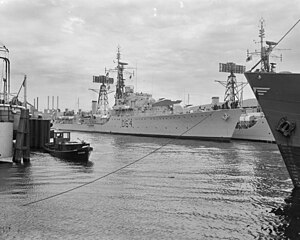This article includes a list of general references, but it lacks sufficient corresponding inline citations. (January 2013) |
 HMS Scorpion in Amsterdam on 29 September 1961
| |
| Class overview | |
|---|---|
| Name | Weapon class |
| Operators | |
| Preceded by | C class |
| Succeeded by | Battle class |
| Planned | 20 |
| Completed | 4 |
| Cancelled | 16 |
| General characteristics as built | |
| Type | Destroyer |
| Displacement |
|
| Length | 365 ft (111 m) o/a, 341.5 ft (104.1 m) p/p |
| Beam | 38 ft (12 m) |
| Draught | 14.5 ft (4.4 m) |
| Propulsion | 2 x Foster-Wheeler water-tube boilers, Parsons double-reduction geared steam turbines, 40,000 shp (30,000 kW) on 2 shafts |
| Speed | 31-knot (57 km/h) |
| Range | 630 tons oil, 5,000 nmi (9,300 km) at 20 knots (37 km/h) |
| Complement | 234 (256 in Battleaxe) |
| Sensors and processing systems |
|
| Armament |
|
| General characteristics (A/D conversion) | |
| Sensors and processing systems |
|
The Weapon class was a class of destroyers built for the British Royal Navy towards the end of World War II. They were the smaller counterpart to the Battle class (which followed them) and were the first new destroyer designs for the Royal Navy since the Second World War Emergency Programme. 20 ships were planned, of which only 13 were laid down and 7 were launched, but the cessation of hostilities resulted in only 4 being completed for service. Two of the ships had been previously ordered (as Celt and Centaur) as part of the planned C class, or 15th Emergency flotilla, of 1944, but the orders were changed to the new design.